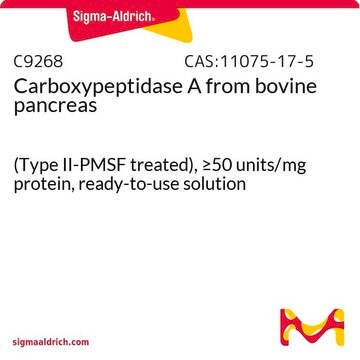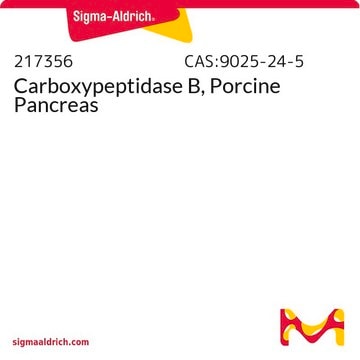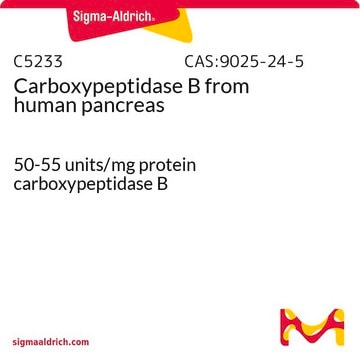C0279
Carboxypeptidase Inhibitor from potato tuber
lyophilized powder
Sign Into View Organizational & Contract Pricing
All Photos(1)
About This Item
Recommended Products
biological source
plant (white russett potato)
form
lyophilized powder
potency
1.1-6.0 nM Ki [CPB]
1.5-3.5 nM Ki [CPA]
mol wt
apparent mol wt 4.075-4.333 kDa
composition
Protein, ≥35% Lowry
solubility
water: soluble 5 mg/mL, clear
storage temp.
−20°C
Biochem/physiol Actions
Broad-spectrum inhibitor of carboxypeptidases of animal digestive-tract origin, but little or no activity against plant and microbial carboxypeptidases. However, recent results suggest it may play a part in resistance to microbial pathogens by preventing digestion of protein.
Packaging
Package size based on protein content
Unit Definition
One μg of inhibitor protein will inhibit the activity of ≥3 μg of carboxypeptidase A by 50% using hippuryl-L-phenylalanine as substrate at pH 7.5 at 25°C.
Physical form
Lyophilized powder containing traces of sodium citrate and sodium chloride; balance primarily non-protein components.
Storage Class
11 - Combustible Solids
wgk_germany
WGK 3
flash_point_f
Not applicable
flash_point_c
Not applicable
ppe
Eyeshields, Gloves, type N95 (US)
Certificates of Analysis (COA)
Search for Certificates of Analysis (COA) by entering the products Lot/Batch Number. Lot and Batch Numbers can be found on a product’s label following the words ‘Lot’ or ‘Batch’.
Already Own This Product?
Find documentation for the products that you have recently purchased in the Document Library.
Customers Also Viewed
Purification and properties of a carboxypeptidase inhibitor from potatoes.
C A Ryan et al.
The Journal of biological chemistry, 249(17), 5495-5499 (1974-09-10)
Jarosław Króliczewski et al.
Scientific reports, 6, 34557-34557 (2016-10-05)
The cytochrome b
David Thompson et al.
The Journal of biological chemistry, 284(37), 24891-24903 (2009-07-11)
We have identified, purified, and characterized three subcomplexes of PA700, the 19 S regulatory complex of the 26 S proteasome. These subcomplexes (denoted PS-1, PS-2, and PS-3) collectively account for all subunits present in purified PA700 but contain no overlapping
Huaqi Tang et al.
Biotechnology and bioengineering, 118(3), 1405-1410 (2020-11-27)
Lack of experimental human models hinders research on Lassa hemorrhagic fever and the development of treatment strategies. Here, we report the first chip-based model for Lassa hemorrhagic syndrome. The chip features a microvessel interfacing collagen network as a simple mimic
Our team of scientists has experience in all areas of research including Life Science, Material Science, Chemical Synthesis, Chromatography, Analytical and many others.
Contact Technical Service











